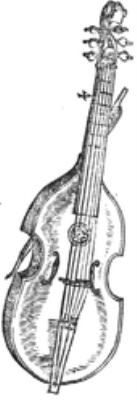
Viola bastarda
Encyclopedia
- Lyra bastarda is a common misnomer for the barytonBarytonThe baryton is a bowed string instrument in the viol family, in regular use in Europe up until the end of the 18th century. In London a performance at Marylebone Gardens was announced in 1744, when Mr Ferrand was to perform on "the Pariton, an instrument never played on in publick before." It most...
.
Viola bastarda refers to a highly virtuosic style of composition or extemporaneous performance, as well as to the altered viol
Viol
The viol is any one of a family of bowed, fretted and stringed musical instruments developed in the mid-late 15th century and used primarily in the Renaissance and Baroque periods. The family is related to and descends primarily from the Renaissance vihuela, a plucked instrument that preceded the...
s created to maximize players' ability to play in this style. In the viola bastarda style, a polyphonic composition is reduced to a single line, while maintaining the same range as the original, and adding divisions, improvisations
Musical improvisation
Musical improvisation is the creative activity of immediate musical composition, which combines performance with communication of emotions and instrumental technique as well as spontaneous response to other musicians...
, and new counterpoint
Counterpoint
In music, counterpoint is the relationship between two or more voices that are independent in contour and rhythm and are harmonically interdependent . It has been most commonly identified in classical music, developing strongly during the Renaissance and in much of the common practice period,...
. The style flourished in Italy
Italy
Italy , officially the Italian Republic languages]] under the European Charter for Regional or Minority Languages. In each of these, Italy's official name is as follows:;;;;;;;;), is a unitary parliamentary republic in South-Central Europe. To the north it borders France, Switzerland, Austria and...
in the late 16th and early 17th centuries. Francesco Rognoni, a prominent composer of divisions, stated that although works using the bastarda techniques could be played by a number of instruments, including organ
Organ (music)
The organ , is a keyboard instrument of one or more divisions, each played with its own keyboard operated either with the hands or with the feet. The organ is a relatively old musical instrument in the Western musical tradition, dating from the time of Ctesibius of Alexandria who is credited with...
, lute
Lute
Lute can refer generally to any plucked string instrument with a neck and a deep round back, or more specifically to an instrument from the family of European lutes....
, and harp
Harp
The harp is a multi-stringed instrument which has the plane of its strings positioned perpendicularly to the soundboard. Organologically, it is in the general category of chordophones and has its own sub category . All harps have a neck, resonator and strings...
, the "queen" of bastarda technique was the viol
Viol
The viol is any one of a family of bowed, fretted and stringed musical instruments developed in the mid-late 15th century and used primarily in the Renaissance and Baroque periods. The family is related to and descends primarily from the Renaissance vihuela, a plucked instrument that preceded the...
because of its agility and large range.
The first use of the term was by Girolamo Dalla Casa
Girolamo Dalla Casa
Girolamo Dalla Casa was an Italian composer, instrumentalist, and writer of the late Renaissance. He was a member of the Venetian School, and was perhaps more famous and influential as a performer than as a composer....
in a 1584 treatise. Rognoni's Selva de varii passaggi (Milan 1620) was the definitive treatise on viola bastarda technique. Earlier bastarda compositions were accompanied by viol consort
Consort of instruments
A consort of instruments was a phrase used in England during the sixteenth and seventeenth centuries to indicate an instrumental ensemble. These could be of the same or a variety of instruments. Consort music enjoyed considerable popularity at court and in households of the wealthy in the...
or plucked instrument such as the lute or harpsichord
Harpsichord
A harpsichord is a musical instrument played by means of a keyboard. It produces sound by plucking a string when a key is pressed.In the narrow sense, "harpsichord" designates only the large wing-shaped instruments in which the strings are perpendicular to the keyboard...
, with another instrument on the bass line. Later compositions were accompanied by continue bass. The last composer to write for the bastarda was Vincenzo Bonizzi, in Alcune opere di diverse auttori a diverse voci, passaggiate principalmente per la viola bastarda (1626).
Viola bastarda music is written for standard viol tuning, in fourths with a third in the middle. Early sources speak of the viola bastarda as a style of playing, and the ranges of pieces written during this time indicate that bastarda pieces were played on whichever size viol was at hand; however, Rognoni describes the standard size of a viola bastarda as between that of a tenor and bass viol, indicating a change in understanding of the term. It may be related to the English division viol
Division viol
The division viol is an English type of bass viol, which was originally popular in the mid-17th century, but is currently experiencing a renaissance of its own due to the movement for historically informed performance...
.

